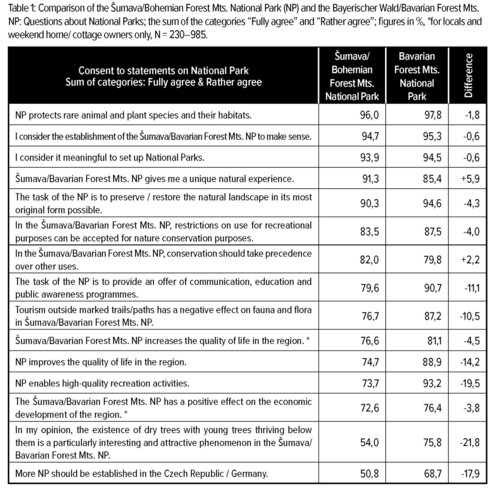The Journal is published by the Nature Conservation Agency of the Czech Republic in cooperation with the Cave Administration of the Czech Republic, the Krkonoše Mts. National Park Administration, the Bohemian Forest Mts. National Park Administration, the Podyjí National Park Administration and the The Bohemian Switzerland National Park Administration. It has been published since 1946.
cs / en
Nature Conservation 2021 — 10. 6. 2021 — Focusing on the Public — Print article in pdf
Introducing a Transboundary Socio-economic Monitoring Scheme in the Šumava and Bavarian Forest Mts.

National parks are large, specially protected areas. They aim to protect natural ecosystems, support undisturbed natural processes, as well as human-determined biodiversity. However, as the national park mission, in addition to the above mentioned, also includes enabling sustainable development, national park management authorities urgently need to ensure long-term monitoring of the fulfilling both the conservation goals and the mission. A transboundary project of the administrations of the Šumava/Bavarian Forest Mts. has mainly addressed the latter point.
The long road to the project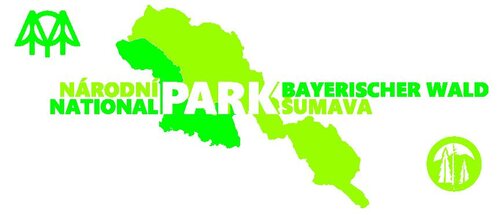
In 2014, there was a major turning point in cooperation between both National Parks. A joint definition of objectives for the direction of both the parks opened up the possibility of new projects and new cooperation. Joint monitoring of visitors was among the first ideas because this type of blanket monitoring activity had been missing, although studies did exist which focussed on specific sub-problems or longer-term monitoring of the selected sites. On the Bavarian side of the border, however, there had been some experience; more specifically, basic surveys were underway there. The activity was conducted by a research team from the University of Natural Resources and Life Sciences, Vienna (BOKU). The aim of the project under preparation was to carry out a similar basic survey on the Czech side, and to subsequently elaborate the qualitative characteristics of visitor satisfaction and their impact on the functioning of the two protected areas. Unfortunately, a suitable funding title had been awaited from 2015 onward as the then INTERREG scheme supporting cross-border cooperation between the Czech Republic and Bavaria was in its final period. Nevertheless, the goal was clear: prepare a project that assesses both the number of visitors and their opinions, wishes, and expectations that they bring with themselves when entering the territory. During the approval process at the Ministry of the Environment of the Czech Republic, the project was supported and subsequently recommended for implementation in all the other National Parks in the Czech Republic.
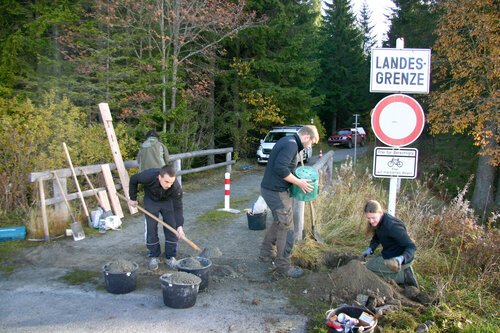
Installing a bicycle counter at a border-crossing point. © Josef Štemberk
Following a successful application, a project entitled “Transboundary Socio-economic Monitoring Scheme in the Šumava/Bohemian Forest Mts./Bohemian Forest Mts. and Bayerischer Wald/Bayerischer Wald/Bavarian Forest Mts. Mts. National Parks” was launched on January 1, 2017 under the cross-border cooperation scheme “Czech Republic – Free State of Bavaria, Goal ETC 2014–2020 (INTERREG V), Priority Axis 2”. The Bayerischer Wald/Bavarian Forest Mts. Mts. National Park Administration became a lead partner, while the Šumava/Bohemian Forest Mts. National Park Administration was a project partner. The project´s aim was to establish and implement a permanent transboundary scheme of visitor monitoring as the main building block of socio-economic monitoring activities in both National Parks. Total project duration was 39 months, including a three-month extension. The project budget was € 672,025.00 (Czech portion of the project: € 280,000); the rate of funding was 85%. Experts from the BOKU (a working group led by Professor Arne Arnberger) were selected as external methodology experts by the tender procedure. They elaborated a methodology (selection of census and survey sites, draft questionnaires, etc.), along with project coordinators from both National Park administrations, and took over the entering data into the database, evaluating the data, and writing internal project reports.
The project was divided into six sections. The basic survey was to determine the number and essential characteristics of visitors. In addition, the following five modules were included: Module 1: Information for visitors, to find out how aware visitors are of National Parks and regions; Module 2: Transboundary recreational use, quantifying cross-border movement of visitors between the two National Parks; Module 3: Rate of acceptance by the local population, examining the attitudes of local residents toward the Šumava/Bohemian Forest Mts. National Park; Module 4: Natural experience looked at the reasons why visitors come to the National Parks, what they expect from their visit, and whether or not their expectations are met; Module 5: Economic benefits from having visitors, which measured the economic effect of visitors on the Šumava/Bohemian Forest Mts. region. The present paper only covers the most important results from the first section, i.e., the basic survey in the Šumava/Bohemian Forest Mts. National Park. The results from the other project modules exceed the possibilities of a single journal article in terms of significance and quantity and therefore, they shall be presented later.
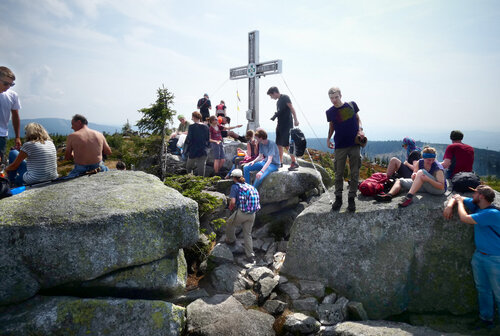
Overcrowding of some tourist destinations at the expense of enjoying
the natural world. © Josef Štemberk
Basic survey
In order to establish a joint transboundary monitoring scheme, some of methods were adopted that had worked well for the Bayerischer Wald/Bavarian Forest Mts. National Park (automated/manual counting and a highly standardized questionnaire) and were tailored to the needs of the Šumava/Bohemian Forest Mts. National Park. In addition, new methods were developed and tested to some extent.
A territory-wide visitor census for the basic survey was carried out between 24 November 2017 and 23 November 2018 in the Šumava/Bohemian Forest Mts. National Park. Automatic counters were installed at 34 different sites to keep records for all incoming and outgoing visitors. In particular, thermal sensors from Eco Counter were used (they can detect all types of visitors and identify their direction of movement). In addition, inductive loops and pressure sensors from Eco Counter were involved to count bikers. A census was also carried out in person at entrances into the Park; this operated for 12 days (6 working days and 6 Saturdays) in the course of the survey period. Based on the intensity of using each site (a total of 79 locations), 2, 4 or 6 days were spent counting visitors at the respective entry sites.
A total of 2,020,000 visits were identified during the monitoring period, with an average of 9.1% of visitors saying they had discontinued their visit on the day of the survey. This makes a total of 1,840,000 visitors to the Šumava/Bohemian Forest Mts. National Park. In comparison, the same period covered about 1,360,000 visits to the Bayerischer Wald/Bavarian Forest Mts. National Park.
The distribution of visitor attendance throughout the year significantly peaked in the summertime, when numbers were up to nine times higher than in the least busy month of November. Saturdays were the peak days, followed by Sundays and holidays. Visitors mostly started their trips between 10 a.m. and midday (31% of the total daily number of visits). Almost no one entered the Šumava/Bohemian Forest Mts. National Park after about 8 p.m. With 126,933 visits per year Modrava/Roklan Brook was the most visited site monitored by the automatic counters, followed by the visitor centre (wolf enclosure) at Srní (116,510 visits). This was confirmed by the evaluation of trip routes that the surveyed visitors plotted on a map. The maps made it possible to assess the territory-wide intensity of use and link it to, for example, visitor types, sizes of visitor groups, and visitor motivation. The northern part of the National Park was generally used more intensely than the southern one. Visitors used almost all roads in the area of Srní, Modrava, Kvilda, and Bučina. On the other hand, in National Park´s other parts, visitors concentrated on a maximum of half of the road network.
The questionnaire used for face-to-face interviews included closed and open-ended questions and was available in Czech and German. The interviews were conducted by trained employees of the Šumava/Bohemian Forest Mts. National Park (Czech and, partly, German-speaking persons), students, guides, and the National Park´s temporary staff. Each visitor (≥ 14 years old) who passed one of the interview sites was asked to participate in the survey. In 12 days, a total of 1,053 people completed the questionnaire in November 2017 to October 2018 at 79 various entry sites into the Šumava/Bohemian Forest Mts. National Park. The interviewing days took place in every season of the year (3 days per season in autumn, winter, spring, and summer), both on working days (6 days on Friday) and at weekends (6 days on Saturday).
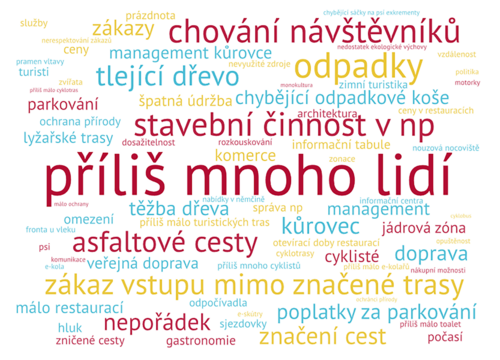
A word cloud covering the outcome of the open question “What do
you not like in the National Park?” Developed by Josef Štemberk
Visitor profile
The average age of the person interviewed was approximately 47 years. 17.6% of the respondents were residents of the so-called Šumava/Bohemian Forest Mts. districts, i.e. those covered by the Šumava/Bohemian Forest Mts. National Park. Overnight guests, who spent on average 4.7 nights in the region, accounted for slightly more than half of the respondents (57.2%). Most visitors had already visited the National Park in the past, saying they would visit it again in the next five years with more than 90% certainty. The main motivation for visiting the Park was “have experience of the landscape and nature”, “draw energy”, “have a rest, relieve mental strain/stress” or, for example, “spend time with family”. In contrast, the least motivation was “learn more about nature”, followed by “thrill/adventure”, and “spend time on one’s own”.
More than two-thirds of the respondents (70.6%) said that recreational opportunities in the Šumava/Bohemian Forest Mts. National Park are not at all limited or not rather limited because the territory enjoys the status of a national park. 15.7% of visitors specifically stated why they feel limited in a negative sense.; they most often mentioned limited access and a ban on leaving marked trails/visitor paths. Three per cent of the respondents perceived some limitations; however, they evaluated them in a positive manner. Almost 90% of respondents assessed the number of visitors’ facilities and the number of tourist trails/visitor paths as an ideal condition. At the same time, over 90% of respondents said they were very satisfied or satisfied with their visit. In terms of quality, trails/paths signage and marking, visitor centres, and information boards scored best. On the other hand, the quality of public toilets, mass public transport, and catering were ranked as the worst. Overnight guests were significantly more satisfied than locals, weekend house/cottage owners, and day-visitors. The open question “what the visitor likes in the National Park” mostly received the following spontaneous answers: “nature”, “quite settings”, and “the landscape”. More than a third of respondents said: “I like everything” when asked “what visitors don’t like”. Others replied: “people” followed by “rubbish”, “visitor behaviour”, “construction activity”, “no entry”, and “asphalt roads”.
Over 90% of the visitors surveyed agreed that National Parks protect and conserve rare species, that they consider declaring National Parks makes sense, and that the task of National Parks is to protect the natural landscape in its most original form possible. In contrast, only 54% of respondents agreed that the existence of dry trees with young thriving trees below them was an attractive phenomenon in the Šumava/Bohemian Forest Mts. National Park, and 49.5% agreed that dead wood was a National Park´s attraction with rich forest vegetation. The comparison with the Bayerischer Wald/Bavarian Forest Mts. National Park is presented in Table 1.
Looking ahead
The data gathered show the importance of the Šumava/Bohemian Forest Mts. National Park for the public. For the first time, the territory-wide number of visitors to the National Park was quantified, with a figure of 1,840,000 visitors per year, namely from December 2017 to November 2018. In addition, the monitoring scheme provided also data on intensity of using the National Park by tourists and their spatial distribution as well as on their structure. The main motivation for the visit was shown to be having experience of the natural world. The vast majority of visitors were satisfied with their visit as well as with the tourist activities offered.
Visitors agreed that nature conservation should take precedence over other uses in the Šumava/Bohemian Forest Mts. National Park, and that restrictions on recreational use for conservation reasons can be accepted.
At the same time, however, the data collected showed that about half of the visitors do not agree that dead wood is an attractive phenomenon for a national park. It was precisely the aim to better understand the attitude of visitors (as well as the local population) toward decaying wood which was behind the questions asked in the other thematic modules of our project.
Whether it is a lack of knowledge of the decaying wood functions and roles in natural forests, on which (as we have known from studies) more than a third of the living organisms depend, or an emotional rejection of something new that a person in Central Europe could only know from a few small remnants of well-preserved primary or old-growth forests before the onset of the European spruce bark beetle (Ips typographus) outbreak in commercial forests that arrived more recently in to the Czech Republic. All of this is subject to further data evaluation.
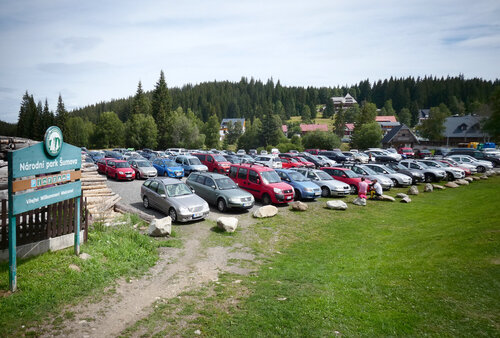
A completely full car park at Modrava. © Josef Štemberk
Introduction of the transboundary socio-economic monitoring scheme in the Šumava/Bohemian Forest Mts. National Park has not only brought a number of new findings and the data collected according to a methodology identical for the Czech and Bavarian sides of border. The objective of the now completed project is also to establish a permanent system of feedback on the Šumava/Bohemian Forest Mts. National Park Administration functioning and performance. The Administration will be able to incorporate the findings and lessons learned in its daily activities as well as in communication with, infomarmation of and rasing awareness among the general public, marketing and public relations. Therefore, the scheme on interviewing and monitoring visitors in both neighbouring National Parks will continue and be further developed.
The project was supported by the European Regional Development Fund under the Transboundary cooperation scheme Czech Republic – Free State of Bavaria, Goal ETC 2014–2020.


